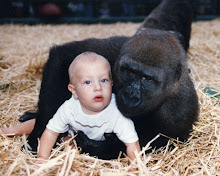As part of their TagFP palate Evrogen have launched a new far red fluorescent protein called mKATE2. Within the optical window beyond 650 nm optimal for light penetration in living tissues, the calculated brightness of mKate2 is at least 2-fold higher compared to any monomeric fluorescent protein reported to date. Bright far-red fluorescence Monomer with successful performance in fusions High pH- and photo stability Fluorescent signal is easily distinguished from background fluorescence. here is a clip of a protein as this monomer glows as florescent green a natural occurring science.
These Monomers can be mixed to skin coloured pigments to give an array of optical effects. But the most inspiring of all of this which is relative old techniques used on canvases to give holographic imagery. I could go on to say some of the new polymer's are been used in data and offer cheaper alternatives to expensive technology today. All this multi media is yet to become a new prospect. These technologies are been developed to enhance the understanding of medical science will also find there way into fashion houses of the future.
For example a three coloured dress may not be a thing of ones imagination, or a stained white garment staying a beautiful white colour, as this becomes the Art of tomorrow. So let us toast to longevity and a brighter future.
Saturday, September 26, 2009
Saturday, September 5, 2009
Masters of Cubism Surrealism
Pablo Picasso (1881-1973) Perhaps the most original and influential artist of the twenty century. Picasso was born in Malaga in Spain, but lived most of his life in France. Throughout his career he experimented with a Variety of styles. His truly original style first emerged during his famed blue period. (1901-1904) in which Pablo worked only in shades of blue. Depicting solitary, melancholy figures. His subsequent period focused largely on circus performances and became known as his rose period (1904-1906). In 1907 he painted Les Demoiselles d’Avignon, which is widely regarded as the birth of cubism. Cubism is an elevated view of a subject stretch across the canvases. This was a new art form for its time. It brought new forms to art (1899-1906) both in architectures, compositions and to every day life this is what makes Pablo such an iconic master.
The depiction of five female nude pictures in sharp, fragmented geometric shapes changed the course of art forever. Thirty years later he painted Guernica, a bold condemnation of blitz Quirigua also known as blanket bombing used in fascist warfare. His truly unique and ever-evolving body of works instantly recognizable the world over. To this day his work elicits mixed reactions, but his embrace of chaos and complete disregard for the accepted rules of art made him a world-class rebel and the father of modern art. The amounts of his works are enormous and can be readily seen for sale in public domain.
The depiction of five female nude pictures in sharp, fragmented geometric shapes changed the course of art forever. Thirty years later he painted Guernica, a bold condemnation of blitz Quirigua also known as blanket bombing used in fascist warfare. His truly unique and ever-evolving body of works instantly recognizable the world over. To this day his work elicits mixed reactions, but his embrace of chaos and complete disregard for the accepted rules of art made him a world-class rebel and the father of modern art. The amounts of his works are enormous and can be readily seen for sale in public domain.
Masters of the Impressionist.
Pierre-Auguest Renoir (1841-1919) Born in Limoges, France, Renoir was an impressionist, but unlike Monet, he preferred figure painting to land scape's, and he often used his wife’s children as models. His paintings were often bright and sunny and lively depictions of family life in the parks gardens of Paris. Additionally his numerous studies of the female nude form are considered to be works of great beauty. The swing, the luncheon of the boat party and the series The bathers are among his better known works.
Vincent Van Gogh (1853-1890) This famous tormented Dutchman who is reputed to have sold just one painting in his life time was born in Groot-Zundert, in the Netherlands. In his early thirties, he moved to Paris to live with his brother Theo an art dealer it was there he met the famous artiest of the day. He eventually moved to southern France, where he produced his most famous works, including Starry Night, Sun Flowers and Bedroom of Arles. During his later years it is said that, Van Gogh battled mental illness it is now revealed suffered from alcoholism he was repeatedly hospitalised, but between the bouts of estranged behaviours he produced an astonishing number of vivid, emotional paintings. With his unique trademark of swirling brushstrokes, often in bright blues, greens and yellows. Eventually overcome by the agony of his mental state now known that was partly due to his lost love, he took his own life with a revolver. Today his works which are deemed priceless artworks then were used then as parchment to carry fish and meat his works are considered masterpieces of expressionism.
Vincent Van Gogh (1853-1890) This famous tormented Dutchman who is reputed to have sold just one painting in his life time was born in Groot-Zundert, in the Netherlands. In his early thirties, he moved to Paris to live with his brother Theo an art dealer it was there he met the famous artiest of the day. He eventually moved to southern France, where he produced his most famous works, including Starry Night, Sun Flowers and Bedroom of Arles. During his later years it is said that, Van Gogh battled mental illness it is now revealed suffered from alcoholism he was repeatedly hospitalised, but between the bouts of estranged behaviours he produced an astonishing number of vivid, emotional paintings. With his unique trademark of swirling brushstrokes, often in bright blues, greens and yellows. Eventually overcome by the agony of his mental state now known that was partly due to his lost love, he took his own life with a revolver. Today his works which are deemed priceless artworks then were used then as parchment to carry fish and meat his works are considered masterpieces of expressionism.
Subscribe to:
Posts (Atom)



